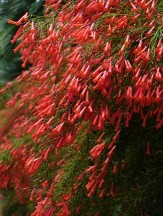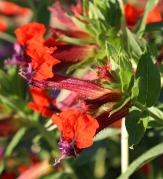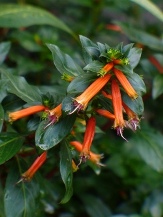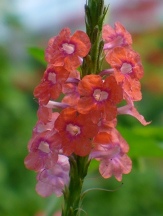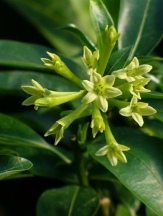Plants for Fall Color
Find plants that develop colorful fall foliage in shades ranging from reds, oranges, yellows, purples, and maroon shades. Some may show all of these colors! More sun generally makes for better fall color.
Tama Beauty Camellia
Camellia japonica 'Tama Beauty'
The medium to large, semi-double to loose peony form flowers are composed of rosy pink to rosy red petals that are edged in a narrow and starkly contrasting bright white band and are centered by a boss of golden stamens often mixed with petaloids. Flowering occurs in early to midseason, October to February, attracting bees and other pollinators. Tama Beauty Camellia is a large flowered Japonica type with a moderate rate of growth and an upright to rounded, densely branching habit maturing into a large rounded evergreen shrub. Provide Camellias with a fertile soil rich in organic matter, with average moisture, and an organic mulch. Images courtesy of Cam Too Camellia Nursery, all rights reserved. Item# 13245
US$19.99
Or
Quantity Exceeds Stock Level
Email Me When Ready
Cannot Ship To: OR
Tama Beauty Camellia
Camellia japonica 'Tama Beauty'
Mini Cart
Categories
- 2024 New Plants
- Agastache
- Angel Trumpets
- Bee Plants
- Bonsai Starter Plants
- Butterfly Plants...
- Camellia & Sasanqua Selector...
- Camellias & Sasanquas
- Cut Flowers
- Deer Resistant Plants
- Epiphyllums
- Figs, Figs, Figs...
- Fragrant Plants
- Fruits & Herbs
- Gardenias
- Gift Certificates
- Gingers
- Great Plant Picks for the Pacific Northwest
- Greg Grant Introductions
- Groundcovers
- Heirloom Plants
- Hibiscus...
- Honeysuckle
- Hoyas
- Hummingbird Plants
- Hydrangeas
- Indoor Plants
- Iris
- Lantanas
- Louisiana Native Plants
- Louisiana Super Plants
- Missouri Botanic Gardens Plants of Merit
- Moon Moth Garden Plants
- Native Plants
- Passionvines
- Perennials - All
- Perennials by Size Class...
- Phlox
- Plants by Flower Color...
- Plants by Foliage Color...
- Plants by Fruit Color...
- Plants for Bogs & Wet Areas
- Porterweeds
- RHS Award of Garden Merit® Plants
- Salt Tolerant Plants
- Salvias
- Shade Tolerant Plants
- Shrubs & Trees - All
- Shrubs by Size Class...
- Songbird Plants
- Succulents & Cacti
- Texas Superstar® Plants
- Top Performers from Mt. Cuba Center Trials
- Tropical Plants
- Turks Cap
- Vines and Vine-like Plants
Information
Top Sellers
We Securely Accept
![]()


